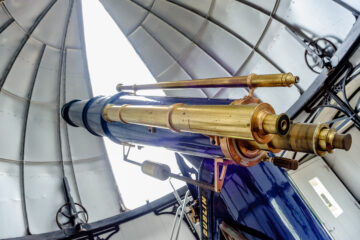VERY MILD, DRY JANUARY, ROUGHLY AVERAGE SUNSHINE
Armagh Observatory reports that January 2020 was very mild, much drier than average and with roughly average sunshine. This was the warmest January at Armagh for eight years, that is, since January 2012.
Total precipitation was 38.65 mm (1.52 inches) including 9 trace values, that is, 38.2 mm if trace values are ignored. This is approximately half the average January precipitation at Armagh. The wettest day was the 13th with 6.3 mm of rainfall associated with passage of Storm Brendan, followed by 6.0 mm on the 28th. Sleet and snow were recorded as falling on the night of the 27th/28th, as well as some heavy snow showers soon after midday on the 28th.
The mean temperature was approximately 6.0 degrees Celsius (42.8 degrees Fahrenheit). This is nearly 1.9 C warmer than the long-term (1796–2010) average January temperature at Armagh and 1.3 C warmer than the most recent (1981–2010) 30-year average. This was the warmest January at Armagh for eight years. The warmest day (that is, the highest maximum air temperature) was 14.1 C on the 7th, followed by 13.0 C on the 31st. This month’s warmest day was the fourth-warmest January day on record at Armagh, that is, since daily maximum and minimum temperature measurements began at Armagh in 1843. The three warmer January days in the Armagh temperature record are 25th January 1847 (15.7 C), 24th January 2016 (15.0 C) and 26th January 2003 (14.7 C).
The coldest day (lowest maximum air temperature) was 5.0 C on the 14th. The warmest night (highest minimum air temperature) was 8.2 C on the 6th, and the coldest night (lowest minimum air temperature) was -1.1 C on the 19th. This coldest night also recorded the sharpest ground frost of the month, namely -7.0 C. In all, January 2020 had 21 nights with ground frost, but only three with air frost.
With 47.0 hours of strong sunshine January 2020 was approximately 5% duller than the long-term (1881–2010) average at Armagh and 1% sunnier than the most recent (1981– 2010) 30-year average. The sunniest day was the 15th with 6.1 hours of strong sunshine, followed by the 12th with 5.5 hours.
These data refer to observations at Armagh Observatory, which has been recording the weather at Armagh since 1795.
FOR FURTHER INFORMATION PLEASE CONTACT: Mark Bailey at the Armagh Observatory, College Hill, Armagh, BT61 9DG. Tel.: 028-3752-2928; FAX: 028-37527174; mark.bailey@armagh.ac.uk



0 Comments